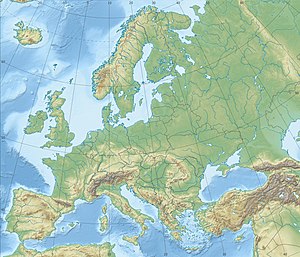Siege of Bellegarde (1793)
| Siege of Bellegarde (1793) | |
|---|---|
| Part of the Pyrénées Orientales, France 42°27′31″N 2°51′33″E / 42.45861°N 2.85917°E | |
| Result | Spanish victory |
The siege of Bellegarde commenced on 23 May 1793 and ended on 24 June 1793 when
Background
King
When Spain went to war with
With the seizure of Céret, Ricardos placed his army nearly in the rear of Bellegarde. After receiving some reinforcements, he advanced farther to the northeast to the vicinity of
Siege

Concurrent with the siege of Bellegarde, Spanish General Antonio Ricardos attacked two French fortresses along the Tech River associated with Fort de Bellegarde, Fort les Bains at Amélie-les-Bains-Palalda 16 kilometers to the northwest and Fort de la Garde at Prats-de-Mollo-la-Preste 31 kilometers to the west. Fort les Bains was sieged on 23 May and the garrison of 350 men surrendered on 3 June after bombardment. The 200 man garrison of Fort de la Garde surrendered on 5 June after the fort's water supply was cut off.[5]
The siege of Bellegarde and its garrison of 1,536 French soldiers began on 23 May. The garrison's firepower included at least 41 cannon and seven mortars. For several weeks the Spanish siege guns pounded Fort de Bellegarde until a breach was made in the main wall. By this time, 42 of the 50 French artillery pieces were dismounted.[6] Facing the prospect of an assault with his defenses compromised, Boisbrulé formally surrendered Bellegarde on 24 June. The remaining soldiers of the garrison marched into captivity. During the month-long siege, the French suffered losses of 30 killed, 56 wounded, and 1,450 captured. Spanish losses are not known.[7]
Results
With the Fort de Bellegarde secured, the Spanish army became able to use the Col de La Pertus as a supply route. Ricardos lunged at the capital of
Footnotes
References
- Goode, Dominic. "Bellegarde". fortified-places.com. Archived from the original on 16 July 2012. Retrieved 18 July 2012.
- Rickard, J. "Battle of Perpignan, 17 July 1793". historyofwar.org. Retrieved 15 July 2012.
- Rickard, J. "Siege of Bellegarde, May-25 June 1793". historyofwar.org. Retrieved 18 July 2012.
- ISBN 1-85367-276-9.
External links
 Media related to Siege of Bellegarde (1793) at Wikimedia Commons
Media related to Siege of Bellegarde (1793) at Wikimedia Commons
| Preceded by Battle of Hondschoote |
French Revolution: Revolutionary campaigns Siege of Bellegarde (1793) |
Succeeded by Battle of Peyrestortes |

